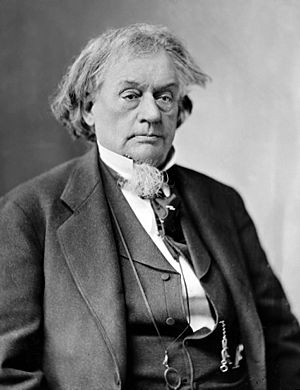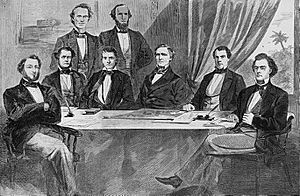Robert Toombs facts for kids
Quick facts for kids
Robert Toombs
|
|
|---|---|
 |
|
| 1st Confederate States Secretary of State | |
| In office February 25, 1861 – July 25, 1861 |
|
| President | Jefferson Davis |
| Preceded by | Position established |
| Succeeded by | Robert Hunter |
| United States Senator from Georgia |
|
| In office March 4, 1853 – February 4, 1861 |
|
| Preceded by | Robert Charlton |
| Succeeded by | Homer Miller |
| Member of the U.S. House of Representatives from Georgia's 8th district |
|
| In office March 4, 1845 – March 3, 1853 |
|
| Preceded by | Constituency established |
| Succeeded by | Alexander Stephens |
| Member of the Georgia House of Representatives from Wilkes County |
|
| In office 1837–1843 |
|
| Personal details | |
| Born |
Robert Augustus Toombs
July 2, 1810 Washington, Georgia |
| Died | December 15, 1885 (aged 75) Washington, Georgia |
| Political party | Whig (Before 1851) Constitutional Union (1851–1853) Democratic (1853–1885) |
| Alma mater | University of Georgia Union College University of Virginia |
| Signature | |
| Military service | |
| Allegiance | |
| Branch/service | |
| Years of service | 1861-1863 (CS Army) 1863-1865 (Georgia Militia) |
| Rank | Brigadier General |
| Commands | Toomb' Brigade |
| Battles/wars | American Civil War |
Robert Augustus Toombs (July 2, 1810 – December 15, 1885) was an important American politician from Georgia. He played a big role in forming the Confederacy. Toombs came from a wealthy family who owned plantations and enslaved people.
He was known for being a powerful speaker in politics. Toombs became the first Secretary of State for the Confederacy. He disagreed with the decision to attack Fort Sumter. Because of this, he resigned from President Jefferson Davis's cabinet.
Toombs later joined the Confederate Army. He was hurt during the Battle of Antietam. After the American Civil War, he traveled to Europe to avoid being arrested. When he returned to Georgia, he refused to ask for a pardon. He still managed to get elected to office in Georgia in 1877.
Contents
Early Life and Schooling
Robert Augustus Toombs was born in 1810 near Washington, Georgia. He was the fifth child of Catherine Huling and Robert Toombs. His father was a planter. Robert's father died when he was only five years old.
He went to private schools first. Then, at age fourteen, he started at Franklin College at the University of Georgia. While there, he was part of the Demosthenian Literary Society. After some trouble at Franklin College, he went to Union College in New York. He graduated from Union College in 1828. Later, he studied law at the University of Virginia Law School.
Marriage and Family Life
In 1830, Robert Toombs married Martha Juliann ("Julia") DuBose. She was his childhood sweetheart. They had three children together. Their first child, Lawrence, died young from scarlet fever. Their daughter Mary Louisa died during childbirth. Their last child, Sarah (Sallie), also died from childbirth problems.
Starting a Career in Law and Politics
Toombs became a lawyer in Georgia in 1830. Soon after, he entered politics. He was elected to the Georgia House of Representatives in 1838. He served a few terms there over several years.
In 1844, Toombs won a seat in the United States House of Representatives. He was re-elected many times and served until 1853. In 1852, he was elected to the United States Senate by the state legislature. In the Senate, he worked closely with his friend Alexander H. Stephens.
Toombs was a member of the Whig Party. When the Whig Party ended, he helped create the Constitutional Union Party. He believed in states' rights, meaning states should have more power.
He was against the Mexican–American War. Toombs believed that President James K. Polk's actions were wrong. He said moving American troops to the Rio Grande was against the law.
Enslaved People and Plantations
Robert Toombs and his brother Gabriel owned large plantations. They used enslaved African Americans to work on these lands. As Toombs became wealthier, he bought more enslaved people.
In 1840, he owned six enslaved people. By 1850, he owned 17. In 1860, he owned 16 enslaved people at his home plantation. He also owned 32 more at another plantation in Stewart County, Georgia.
One of his enslaved people, Garland H. White, escaped before the Civil War. He later became a soldier and chaplain in the Union Army. Other enslaved people were freed by the Union Army. William Gaines and Wesley John Gaines, who were also enslaved by Toombs, became important church leaders.
From Supporting the Union to Joining the Confederacy
During the 1840s and 1850s, Toombs tried to balance national laws with his own interests. He was against the annexation of Texas at first. But he promised to defend Texas once it became a state. He also opposed the Mexican–American War.
He supported the Compromise of 1850. This was an agreement that tried to ease tensions over slavery. Toombs was against states leaving the Union at that time. He helped create the Georgia Platform, which supported the Compromise. He thought leaving the Union was not practical.
Toombs wanted slavery to expand into new territories like California and New Mexico. He believed that all people, including slaveholders, should be treated equally in these territories. He said if the South's rights were violated, there would be "discord forever."
From 1853 to 1861, Toombs served in the United States Senate. He joined the Democratic Party because other parties were not strong enough. He supported the Kansas–Nebraska Act of 1854. This act allowed new territories to decide if they would allow slavery.
In 1856, Toombs was present when Congressman Preston Brooks attacked Senator Charles Sumner. Toombs later said he approved of Brooks' actions.
In 1856, Toombs introduced a bill for a new constitution in Kansas. This bill offered some compromises to anti-slavery leaders. However, it did not allow the people of Kansas to vote on the constitution.
Toombs was known for his strong personality and powerful speeches. He was a popular figure in Georgia politics.
Secession and the Confederacy
In the 1860 presidential election, Toombs supported John C. Breckinridge. After Abraham Lincoln was elected, Toombs urged Georgia to leave the Union. He gave a farewell speech in the U.S. Senate in January 1861. In his speech, he stated his belief in white supremacy and his opposition to equal rights for Black people. He said that the South would fight to protect its way of life.

Toombs returned to Georgia and pushed for immediate secession. His strong influence helped convince many to support leaving the Union. He hoped to become the president of the new Confederate nation. However, Jefferson Davis was chosen instead.
Toombs was then appointed as the Secretary of State. He was the only person in Davis's cabinet who disagreed with attacking Fort Sumter.
Serving as an Army General
After a few months, Toombs resigned from his cabinet position. He joined the Confederate States Army. He became a brigadier general in July 1861. He led troops in several major battles. These included the Peninsula Campaign, Seven Days Battles, and Maryland Campaign.
He was wounded in the hand at the Battle of Antietam. There, he bravely defended Burnside's Bridge.

Toombs resigned from the Confederate Army in March 1863. He went back to Georgia. There, he became a colonel in the Georgia Militia. He often criticized President Davis and the Confederate government. He was against drafting soldiers and suspending certain rights. Some newspapers even suggested he was close to treason. In the Battle of Columbus (1865), Toombs led the defense of a key bridge.
When the war ended, Toombs avoided arrest. He traveled through Georgia and Alabama. He then went by boat to New Orleans, Havana, and finally Europe. He arrived in Paris, France, in July 1865. He was trying to avoid being put on trial as a Confederate leader.
Later Years and Legacy
His wife, Julia, returned to Georgia in late 1866. She went to help care for their grandchildren after their last child, Sallie, died. Toombs missed his wife and returned to Georgia in 1867. However, he refused to ask the president for a pardon. This meant he could not vote or hold political office during the Reconstruction era.
Despite this, Toombs rebuilt his successful law practice. He worked with his son-in-law, Dudley M. DuBose. Toombs slowly regained political power in Georgia. He played a major role in the Georgia constitutional convention of 1877. This was the year federal troops left the South. He showed his strong political skills again. He became popular by criticizing railroads and state investments in them.
In 1883, Toombs faced many losses. His son-in-law, Dudley M. DuBose, died. His long-time friend and political ally, Alexander H. Stephens, also died. In September, his beloved wife, Julia, passed away. After these losses, Toombs became very sad and eventually lost his eyesight.
Robert Toombs died on December 15, 1885. He was buried at Resthaven Cemetery in Wilkes County, Georgia. He was buried with his wife, daughter, and son-in-law. He was survived by four grandchildren.
The Georgia Department of Natural Resources now owns Toombs's house. Wilkes County, Georgia, operates it as the Robert Toombs House State Historic Site. Several places are named after Robert Toombs:
- Toombs County, Georgia
- Wilkin County, Minnesota was once called Toombs County.
- The Toombs Judicial Circuit, which includes several county courts.
- The Georgia town of Toomsboro.
- Camp Toombs in Toccoa, Georgia, a training base during World War II.
See also

